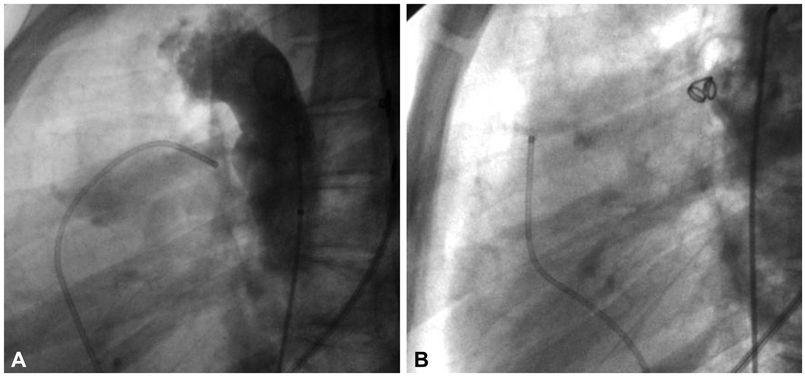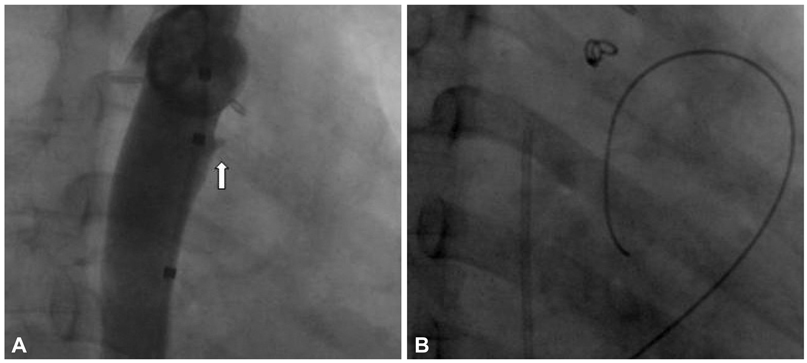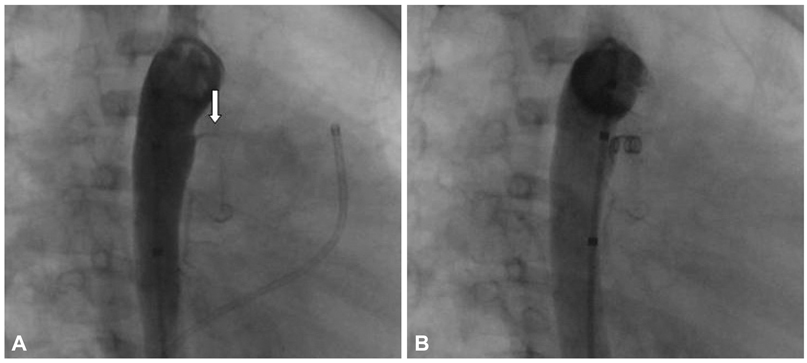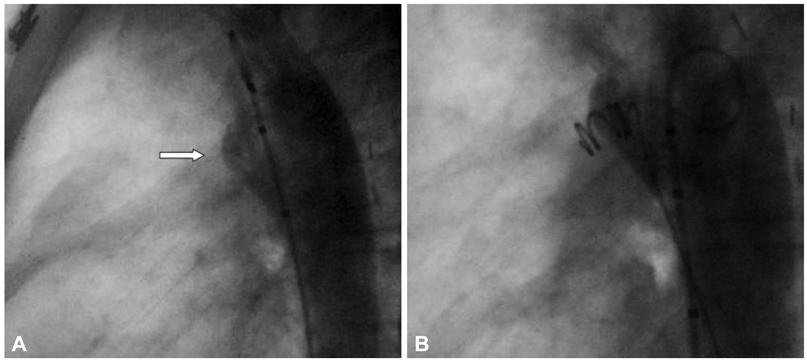Korean Circ J.
2011 Nov;41(11):654-657. 10.4070/kcj.2011.41.11.654.
Transcatheter Closure of a Residual Patent Ductus Arteriosus After Surgical Ligation in Children
- Affiliations
-
- 1Department of Pediatric Cardiology, Gaziantep University Medical Faculty, Gaziantep, Turkey. osmanbaspinar@hotmail.com
- KMID: 2225073
- DOI: http://doi.org/10.4070/kcj.2011.41.11.654
Abstract
- BACKGROUND AND OBJECTIVES
To assess the safety and efficacy of transcatheter closure of residual ductal flow after initial surgical ligation of the arterial duct.
SUBJECTS AND METHODS
Between June 2005 and December 2009, transcatheter occlusion of residual postsurgical ductus arteriosus was performed in six children.
RESULTS
The mean patient age was 10+/-5.5 years; mean post-procedural time since the initial surgical closure was 6.3+/-4.5 years. The mean diameter of the patent ductus arteriosus on angiography was 1.3+/-0.5 mm (range, 0.8 to 2.4 mm). Three different types of coils were used successfully without any complications.
CONCLUSION
Transcatheter occlusion of residual postsurgical arterial duct is a safe and successful procedure. However, attention should be paid due to the distorting shape of the arterial duct.
Keyword
Figure
Cited by 1 articles
-
Persistent Shunting 50 Years after Surgical Patent Ductus Arteriosus Ligation
Eustaquio Maria Onorato, Gregory Popusoi, Armando Pucciarelli, Tullio Tesorio
Korean Circ J. 2021;51(10):877-879. doi: 10.4070/kcj.2021.0210.
Reference
-
1. Zucker N, Qureshi SA, Baker EJ, Deverall PB, Tynan M. Residual patency of the arterial duct subsequent to surgical ligation. Cardiol Young. 1993. 3:216–219.2. Sørensen KE, Kristensen B, Hansen OK. Frequency of occurrence of residual ductal flow after surgical ligation by color-flow mapping. Am J Cardiol. 1991. 67:653–654.3. Demir T, Oztunc F, Cetin G, et al. Patency or recanalization of the arterial duct after surgical ligation and transfixion. Cardiol Young. 2007. 17:48–50.4. Podnar T, Masura J. Transcatheter occlusion of residual patent ductus arteriosus after surgical ligation. Pediatr Cardiol. 1999. 20:126–130.5. Kusa J, Szkutnik M, Czerpak B, Bialkowski J. Percutaneous closure of previously surgical treated arterial ducts. EuroIntervention. 2008. 3:584–587.6. Ovaert C, McCrindle BW, Nykanen D, Freedom RM, Benson LN. Transcatheter management of residual shunts after initial transcatheter closure of a patent arterial duct. Can J Cardiol. 2003. 19:1493–1497.7. Moore JW, Levi DS, Moore SD, Schneider DJ, Berdjis F. Interventional treatment of patent ductus arteriosus in 2004. Catheter Cardiovasc Interv. 2005. 64:91–101.8. Jones JC. Twenty-five years experience with surgery of patent ductus arteriosus. J Thorac Cardiovasc Surg. 1965. 50:149–165.9. Lloyd TR, Beekman RH 3rd. Clinically silent patent ductus arteriosus. Am Heart J. 1994. 127:1664–1665.
- Full Text Links
- Actions
-
Cited
- CITED
-
- Close
- Share
- Similar articles
-
- Three Cases of Hemolysis After Transcatheter Closure of A Patent Ductus Arteriosus
- Nonsurgical Treatment for Severe Hemolysis Following Transcatheter Closure of the Patent Ductus Arteriosus Using the Rashkind Umbrella Device
- Nonsurgical closure of patent ductus arteriosus with the rashkind PDA occluder system
- Aneurysm after Surgical Ligation of Patent Ductus Arteriosus: A Case Report
- PDA Clipping by Using 2mm Thoracoscope





